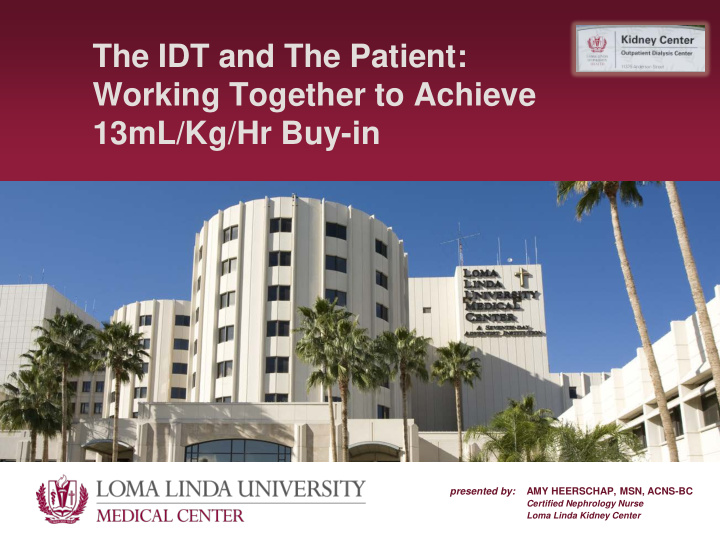



The IDT and The Patient: Working Together to Achieve 13mL/Kg/Hr Buy-in presented by: AMY HEERSCHAP, MSN, ACNS-BC Certified Nephrology Nurse Loma Linda Kidney Center
BACKGROUND: All organ stunning has an impact on patient quality of life. Balancing and managing “between treatment” Interdialytic Weight Gain (IDWG) avoids complications.
PURPOSE: The Interdisciplinary Team (IDT) needed to work together to achieve a less than 13mL/Kg/Hr UF buy-in prior to CMS mandated implementation January 1, 2018. The Medical Director set the goal at 12/mL/Kg/Hr for added patient safety.
CONCEPTUAL FRAMEWORK: All patients on dialysis were educated toward the same goal by nursing staff. The dietitians provided patient education material for fluid management. Social Workers assisted support of the change through conversations shared with the patients at chair-side.
METHODOLOGY: The IDT developed appropriate diet and fluid restriction regimens to accommodate individual patient needs. All patients were educated on the regimen. Each patient was coached by the dietitians and given a document specific to their target weight goal and IDWG with the 12/mL/Kg/Hr UF restrictions. Assessment of patient adherence to the newly defined intradialytic weight gains were accomplished through structured IDWG assessments. Loose initiation of the 12/mL/Kg/Hr UF restriction was implemented in September 2017 and fully enforced in January 2018.
FINDINGS: Initial UF data in August 2017 identified 14% of patients consistently above the 5% estimated dry weight (EDW) goals set for them. Patients were sent to the hospital for fluid overload related admissions 36 times overall in 2017; 15 of those admissions occurred in the first five months of that year. In the five comparative months of 2018, only four admissions occurred.
IMPLICATIONS FOR PRACTICE: After discussing implementation with one dietitian, a particular patient on dialysis stated: “I am really happy everyone is getting a strict goal because sometimes I went home feeling really bad, and now I adhere to a strict regimen and I feel better that I know what my limits are.” Education and knowledge is the best facilitator of success when implementing change. The Interdisciplinary Team must work to continually reinforce the standards set by CMS.
CONCLUSIONS: When presented with mandated regulations, dialysis treatment centers must rise to implement patient fluid removal objectives within specific goals. Our IDT has successfully transitioned our patients on hemodialysis to a safe ultrafiltration value without complications.
CONCLUSIONS: When implementing change toward fluid adherence, patient accountability is key. Given the option for success through knowledge, patients on dialysis will adhere to a strict fluid regimen and thus an improved quality of life.
This presentation is based on a manuscript submitted and accepted for publication in the Sept/Oct 2018, Nephrology Nursing Journal. Volume 45, Number 5. Permission to present this data at this conference has been granted by the publisher. Thank You to the Kidney Center Interdisciplinary Team, Physicians, Nursing Staff, Dietitians, Social Workers, and patients who worked toward this goal with great dedication and enthusiasm.
Recommend
More recommend